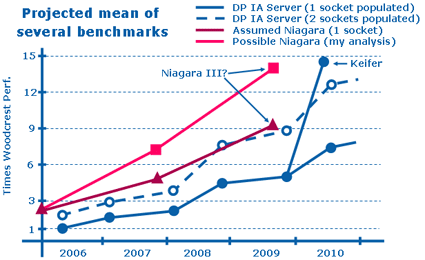32-Core Processors: Intel Reaches For (The) Sun
The Project "Keifer" Awakening

Intel is of rolling out its Core 2 micro-architecture now. The Xeon 5100 server processor aka Woodcrest was released only weeks ago, Core 2 Duo for the desktop (Conroe) is expected on July 27th and the mobile version Merom will follow only weeks later. The next milestone is quad-core processors, which the firm will produce by fitting two Woodcrest dual cores inside a physical processor package (Clovertown). You may have realized that there is a product development pattern behind recent and upcoming Intel multi core processor releases. Amazingly enough, Intel has been studying Sun's UltraSPARC T1 (Niagara) to come up with a radical processor redesign for 2010 that could perform 16 times faster than Woodcrest. This is no marketing blurb, guys; this is technical intelligence from within the Borg collective.

Single/dual socket Core 2 micro-architecture versus Sun's Niagara in best/worst case scenarios. Intel believes it can beat the deadly dinosaur by 2010. The steep Intel slopes for 2008 and 2010 represent the upgrades to 45 and 32 nm as well as possible micro-architecture updates.
I have to say I can't remember performance gains anywhere near 16x in only four years. Comparing a 2002 Pentium 4 3.06 GHz with a Core 2 Extreme 2.93 GHz will give you a two to five fold increase - if most. 16x more performance by 32 cores in 2010 versus today's two cores, should it come true, equals linear scaling, which means that performance would double with the core count. Many of you will say this is utterly impossible, because even sustaining the clock speed levels at doubled core count might be difficult - and I agree, unless you start to think out of the box.
Santa Clara had some of its best brains compare the server processor roadmap with Sun's UltraSPARC T1 and expected future offsprings. The result is a project code-named Keifer. Although it was designed to come up with architecture to beat the pants off Sun in the server market by 2010, Keifer may easily be the technical basis for future server and mainstream processors as well.
Join our discussion on this topic
Speak out in the Toms's Hardware reader survey!
Stay On the Cutting Edge: Get the Tom's Hardware Newsletter
Get Tom's Hardware's best news and in-depth reviews, straight to your inbox.
Most Popular



